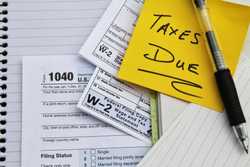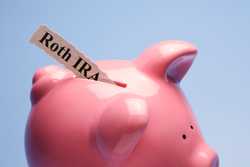What Is the Rule of 55 And How Does It Work?

Our evaluations and opinions are not influenced by our advertising relationships, but we may earn a commission from our partners’ links. This content is created by TIME Stamped, under TIME’s direction and produced in accordance with TIME’s editorial guidelines and overseen by TIME’s editorial staff. Learn more about it.
The rule of 55 allows penalty-free withdrawals from a 401(k) and 403(b) if you leave a job during or after the calendar year you turn age 55. This is an exception to the IRS rule that levies a 10% penalty on withdrawals from employer-sponsored retirement plans before age 59½.
Here is a look at how rule of 55 works and whether or not it makes sense to apply it to your circumstances.
INVESTMENT AND INSURANCE PRODUCTS ARE: NOT A DEPOSIT • NOT FDIC INSURED • NO BANK GUARANTEE • MAY LOSE VALUE
J.P. Morgan Wealth Management is a business of JPMorgan Chase & Co., which offers investment products and services through J.P. Morgan Securities LLC (“J.P. Morgan”), a registered broker dealer and investment adviser, member FINRA and SIPC. TIME Stamped is a publisher of J.P. Morgan, (“Publisher”). The Publisher will receive compensation from J.P. Morgan if you provide contact details to speak with a J.P. Morgan representative. Compensation paid to the Publisher will be up to $500 per completed contact form. Compensation provides an incentive for the Publisher to endorse J.P. Morgan and therefore information, opinions, or referrals are subject to bias. J.P. Morgan and the Publisher are not under common ownership or otherwise related entities, and each are responsible for their own obligations. Investing involves market risk, including possible loss of principal, and there is no guarantee that investment objectives will be achieved.
Under the rule of 55, the IRS permits you to withdraw money from your current 401(k) or 403(b) plan before age 59½ without paying a 10% penalty on the amount withdrawn if both of the following are true: (1) Withdrawals occur in the year you turn 55 or later, and (2) you have left your employer.
“The rule applies regardless of how your employment ended with your employer, and withdrawals under the rule of 55 must be from your current employer’s 401(k) or 403(b) accounts,” explains Nicole Birkett-Brunkhorst, senior wealth planner, U.S. Bank private wealth management, who is based in St. Louis, Mo. “You cannot make withdrawals under the rule of 55 from an old 401(k) or 403(b), and this rule does not apply to individual retirement accounts (IRAs).”
Keep in mind, however, that even though you can withdraw money penalty-free, you will still need to pay income taxes on the amount withdrawn. “Distributions from your workplace retirement plan will be subject to a 20% income tax withholding that will be applied to the federal income taxes due,” Birkett-Brunkhorst adds.
There is no limit to the amount that can be withdrawn from a qualified plan under the rule of 55, assuming a plan participant meets the qualifying criteria—and that the company permits these withdrawals. Birkett-Brunkhost points out that not every company plan permits them. If they do, you need to follow your employer’s rules.
“However, it should be noted again that the rule of 55 distributions must adhere to the terms of the qualified plan itself. For example, one plan may permit withdrawals at the plan participant’s discretion, while another may require the entire account be liquidated in a lump sum,” says Jesse Little, senior director of advice, Wells Fargo Wealth and Investment Management, who is based in Palm Beach, Fla. "In the case of the latter scenario, the plan participant might be forced to withdraw more funds than they’d like, which could create a huge ordinary income tax liability.”
Ideally, consult with a tax expert before moving ahead, and review your other resources and options. As noted below, there are tax-savings opportunities but also potential losses in tapping your retirement funds early, even if you can do so without incurring the 10% early withdrawal penalty. And there may be other ways to raise income.
If you are considering using the rule of 55, keep in mind the following :
If you’re looking to retire early, the rule of 55 could serve as an income-replacement strategy. It's flexible and allows you to determine how much or how little to withdraw from your 401(k) or 403(b) account without locking in the fixed distribution schedule required by a substantially equal periodic payments (SEPP) plan, another complex way of tapping retirement monies early and avoiding the penalty.
Consider the tax-planning opportunities the rule of 55 could offer if you’re in a lower income tax bracket. For example, rule-of-55 withdrawals may allow you to maximize lower federal tax brackets and help minimize the size of your required minimum distributions down the road.
Financial experts can help you identify these opportunities and plan a solid retirement plan based on your financial profile.
INVESTMENT AND INSURANCE PRODUCTS ARE: NOT A DEPOSIT • NOT FDIC INSURED • NO BANK GUARANTEE • MAY LOSE VALUE
J.P. Morgan Wealth Management is a business of JPMorgan Chase & Co., which offers investment products and services through J.P. Morgan Securities LLC (“J.P. Morgan”), a registered broker dealer and investment adviser, member FINRA and SIPC. TIME Stamped is a publisher of J.P. Morgan, (“Publisher”). The Publisher will receive compensation from J.P. Morgan if you provide contact details to speak with a J.P. Morgan representative. Compensation paid to the Publisher will be up to $500 per completed contact form. Compensation provides an incentive for the Publisher to endorse J.P. Morgan and therefore information, opinions, or referrals are subject to bias. J.P. Morgan and the Publisher are not under common ownership or otherwise related entities, and each are responsible for their own obligations. Investing involves market risk, including possible loss of principal, and there is no guarantee that investment objectives will be achieved.
There can also be a significant drawback to implementing the rule—reducing your retirement savings prematurely, especially if you don’t need to do so. When you withdraw at 55, you forfeit all the potential tax-free growth between age 55 and 73 when required minimum distributions start.
An interesting provision is that public safety workers may be able to make penalty-free withdrawals starting five years earlier—age 50—using the rule of 55.
There are a few other ways to avoid an early withdrawal penalty including:
The IRS allows early withdrawals without the penalty for specific financial hardships. These include medical expenses, buying a first home, specific expenses for education, and up to $5,000 to cover costs related to the birth or an adoption of a child, among others. Keep in mind, however, that you will still owe taxes on the amount withdrawn. Make sure to check IRS rules to understand the specific requirements for the different hardship withdrawals.
Consider taking a 401(k) loan rather than taking an early withdrawal, if your plan allows it. In this scenario, you are taking a loan against your own assets, and agreeing to pay it back.
It may make sense to look into securing a personal loan should you need funds short-term.
With the rule of 55, you can take early penalty-free withdrawals from employer-sponsored plans, such as a 401(k) or 403(b), if you meet specific criteria. The rule applies if you retire, quit, or lose a job during or after the calendar year that you turn age 55.
But even if you are eligible, put careful thought into this decision. If you retire early or lose your job, these funds can come in handy to take care of your living expenses. But if you find another job and can cover your expenses—or have other resources you could tap—experts say it may not be the best course to withdraw from your retirement accounts early.
The rule of 55 was enacted in 1988 as a part of the Technical and Miscellaneous Revenue Act. The act made amendments to the tax code of 1968.
How much you should have in your 401(k) at age 55 depends on a number of factors, including when you plan to retire and what you anticipate your lifestyle will be. As a rule of thumb, Fidelity Investments suggests that at age 50, you should have approximately six times your annual salary in your 401(k) and by age 60 eight times.
Under rule72(t), you are allowed to make penalty-free withdrawals from a 401(k), 403(b), or IRA by using substantially equal periodic payments (SEPPs). The biggest difference with rule 72t is you’re required to take distributions continuously for five years or until you turn 59 1/2, whichever occurs later. Also, unlike rule 72(t), the rule of 55 isn’t applicable to IRAs.
According to Birkett-Brunkhorst, the rule of 55 is more flexible than rule 72(t) as it allows you to determine when funds are withdrawn from your workplace plans.
The information presented here is created by TIME Stamped and overseen by TIME editorial staff. To learn more, see our About Us page.




